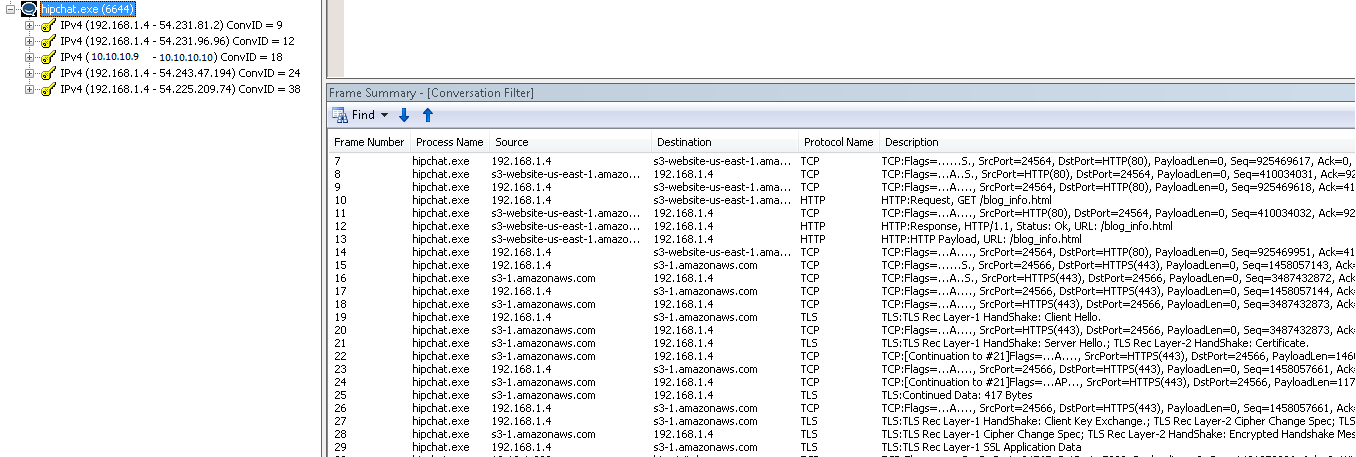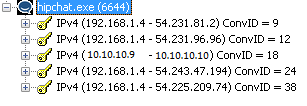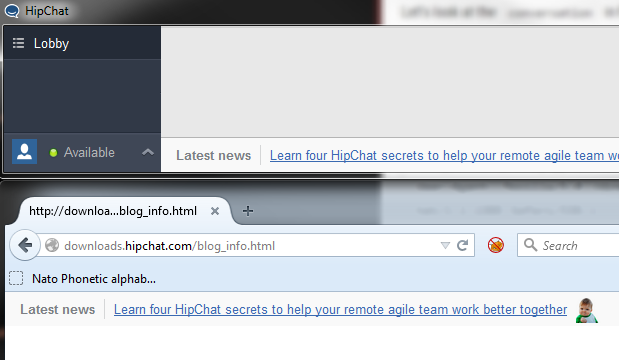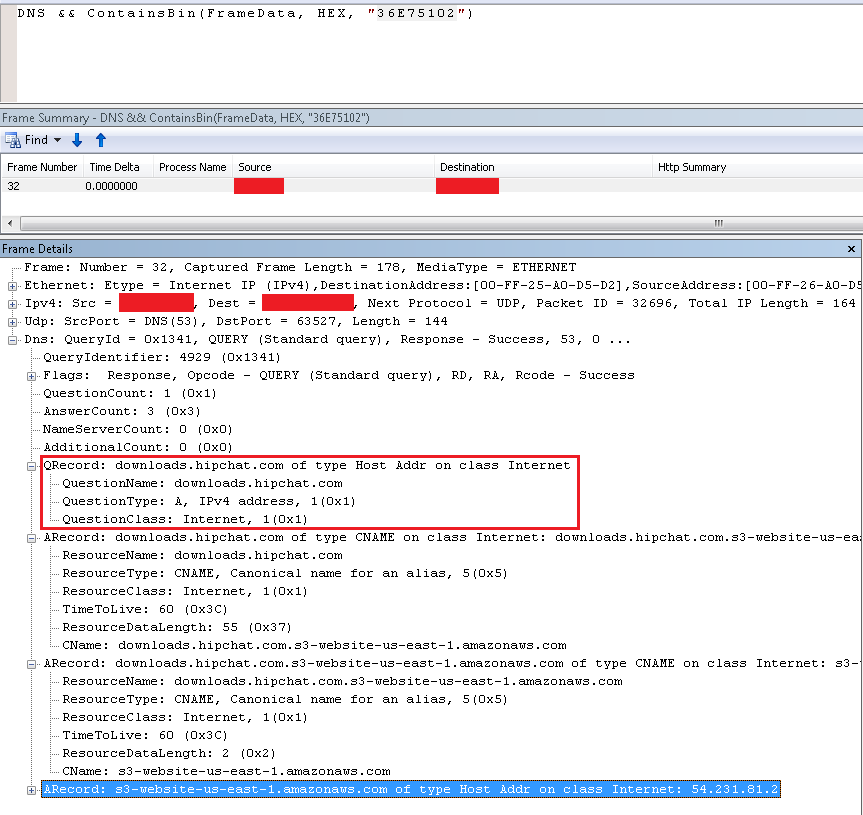
2015-10-09 08:05:24 Author: parsiya.net(查看原文) 阅读量:66 收藏
This is a slightly different version of a series of blog post that I wrote on our internal blog about proxying. I see that proxying traffic is a time consuming step in testing thick client applications so I thought I would share what I know. I tackled Hipchat. Why Hipchat? Because it uses a known protocol (XMPP) and I thought it's an interesting application.
I used Hipchat Windows client version 2. At the time of writing version 4 is in beta. In this part we will see how we can identify endpoints from traffic captures even when they are behind a load balancer/shared hosting etc. In next parts we will start proxying.
I will be using the following tools in this part:
- Microsoft Network Monitor (Netmon). You can also use Wireshark.
- Powershell/Command Prompt/etc: I am using Windows but I am sure you can find the equivalent commands if you are fancy ;)
- Procmon
You can deploy your own Hipchat server by downloading a VM. You will need a license (or an evaluation version) or you can buy a 10 license server for 10 bucks.
Note: In these posts, the Hipchat server is named hipchatserver.com and its IP is 10.10.10.10 (these are just examples). Some of the screenshots are edited to hide the actual IPs and replace them with samples. My machine's sample IP address for the network interface that hosts the Hipchat server is 10.10.10.9.
Run Netmon and Procmon as admin and run HipChat. We already know how to do traffic attribution. I was not logged into any chatrooms, so Hipchat is not loading any extra content (e.g. images linked in rooms).
In Netmon we also see the following endpoints:
- 10.10.10.10
- 54.231.81.2
- 54.231.96.96
- 54.231.47.194
- 54.225.209.74
 Traffic in Netmon
Traffic in Netmon
Traffic in Netmon, click to view full-size image.
You will notice that I have a slightly different layout in Netmon now. I have removed time related columns. Right click any column name and select Choose Columns. There are also different layouts like HTTP Troubleshoot.
 Endpoints in Netmon
Endpoints in Netmon
In Procmon we can see five endpoints:
- hipchatserver.com:5222
- s3-website-us-east-1.amazonaws.com:http
- s3-1.amazonaws.com:https
- ec2-54-531-47-194.compute-1.amazonaws.com:https
- ec2-54-225-209-74.compute-1.amazonaws.com:https
 Endpoints in Procmon
Endpoints in Procmon
Procmon filters are:
- ProcessName is Hipchat.exe
- Operation is TCP Connect
Now we need to find out more about these endpoints (e.g. their actual address/URL etc). Based on their temporal sequence in Procmon and Netmon we have some insights.
2.1 – 10.10.10.10 – hipchatserver.com
This is easy. It's the Hipchat server at hipchatserver.com.
PS C:\> nslookup 10.10.10.10
Server: zzzz.com
Address: 10.10.10.2
Name: hipchatserver.com
Address: 10.10.10.10
PS C:\> ping -a 10.10.10.10
Pinging hipchatserver.com [10.10.10.10] with 32 bytes of data:
...2.2 – 54.231.81.2 – s3-website-us-east-1.amazonaws.com
This is where things start to become interesting. Let's re-use our old tricks.
PS C:\> nslookup 54.231.81.2
Server: zzzz.com
Address: 10.10.10.2
Name: s3-website-us-east-1.amazonaws.com
Address: 54.231.81.2
PS C:\> ping -a 54.231.81.2
Pinging s3-website-us-east-1.amazonaws.com [54.231.81.2] with 32 bytes of data:
...It seems like the second endpoint is hosted on an AWS S3 bucket. S3 buckets are mainly storage containers but they can also host static websites like this website. But we won't find anything if we go to that address. s3-website-us-east-1.amazonaws.com is the east coast AWS data center which is located in Northern Virginia. You will get a different endpoint based on where you are located.
Let's look at the conversation in Netmon. This is similar to Follow TCP/UDP Stream in Wireshark but unfortunately not as good.
 Fetching blog_info.html
Fetching blog_info.html
We are in luck, we can see a GET request over HTTP. Let's look at it's payload:
GET /blog_info.html HTTP/1.1
Accept: text/html,application/xhtml+xml,application/xml;q=0.9,*/*;q=0.8
User-Agent: Mozilla/5.0 (Windows NT 6.1; WOW64) AppleWebKit/538.1 (KHTML, like Gecko) HipChat/2.2.1388 Safari/538.1
Connection: Keep-Alive
Accept-Encoding: gzip, deflate
Accept-Language: en-US,*
Host: downloads.hipchat.comNote the User-Agent. Hipchat is fetching http://downloads.hipchat.com/blog_info.html. This is the Latest News at the bottom of the Hipchat client. Notice that it is being loaded over HTTP and surprisingly it is not available over TLS (try accessing https://downloads.hipchat.com/blog_info.html) does not work. In fact you cannot access https://downloads.hipchat.com.
 Latest News fetched over HTTP ;)
Latest News fetched over HTTP ;)
2.2.1 But what if this request was over TLS?
Then we would have seen the TLS handshake and then encrypted data. Even by looking at the Common Name (CN) field in server's certificate in 2nd part of the TLS handshake (Server Hello) we wouldn't have been able to discover the endpoint.
Traffic in Netmon, click to view full-size image.
We are going to have to look at DNS requests. We know the endpoint's IP address so we will try to find the DNS request that had this IP in its answer. The endpoint's IP address is 54.231.81.2 which is 36E75102 in Hex. In Netmon, select All Traffic (In Netmon DNS traffic is not included in process traffic) and enter the following filter:
DNS && ContainsBin(FrameData, HEX, "36E75102")This filter searches for the IP address in DNS traffic. It will find the DNS query that returned this IP address.
 downloads.hipchat.com
downloads.hipchat.com
As we can see, it is downloads.hipchat.com.
IP to Hex conversion can be done online, by hand or using Python:
| |
2.3 – 54.231.96.96 – s3-1.amazonaws.com
Same trick. 54.231.96.96 in Hex is 36E76060 so filter is:
DNS && ContainsBin(FrameData, HEX, "36E76060")which points to s3.amazonaws.com. As we will see in part two, this is the request to load the emoticon shown with latest news, in this case it is the success kid image macro.
- Dns: QueryId = 0xC28D, QUERY (Standard query), Response - Success, 53, 0 ...
QueryIdentifier: 49805 (0xC28D)
+ Flags: Response, Opcode - QUERY (Standard query), RD, RA, Rcode - Success
QuestionCount: 1 (0x1)
AnswerCount: 3 (0x3)
NameServerCount: 0 (0x0)
AdditionalCount: 0 (0x0)
- QRecord: s3.amazonaws.com of type Host Addr on class Internet PS C:\> python
QuestionName: s3.amazonaws.com
QuestionType: A, IPv4 address, 1(0x1)
QuestionClass: Internet, 1(0x1)
- ARecord: s3.amazonaws.com of type CNAME on class Internet: s3.a-geo.amazonaws.com
ResourceName: s3.amazonaws.com
ResourceType: CNAME, Canonical name for an alias, 5(0x5)
ResourceClass: Internet, 1(0x1)
TimeToLive: 2554 (0x9FA)
ResourceDataLength: 11 (0xB)
CName: s3.a-geo.amazonaws.com
- ARecord: s3.a-geo.amazonaws.com of type CNAME on class Internet: s3-1.amazonaws.com
ResourceName: s3.a-geo.amazonaws.com
ResourceType: CNAME, Canonical name for an alias, 5(0x5)
ResourceClass: Internet, 1(0x1)
TimeToLive: 1555 (0x613)
ResourceDataLength: 7 (0x7)
CName: s3-1.amazonaws.com
- ARecord: s3-1.amazonaws.com of type Host Addr on class Internet: 54.231.96.96
ResourceName: s3-1.amazonaws.com
ResourceType: A, IPv4 address, 1(0x1)
ResourceClass: Internet, 1(0x1)
TimeToLive: 4 (0x4)
ResourceDataLength: 4 (0x4)
IPAddress: 54.231.96.962.4 – 54.243.47.194 – ec2-54-243-47-194.compute-1.amazonaws.com
This is easy, we can just go to http://ec2-54-243-47-194.compute-1.amazonaws.com and observe that it is http://www.hipchat.com. Interesting thing, if you go to http://www.hipchat.com in your browser, it will redirect to the HTTPs version of the website. Going to the Amazon EC2 address is the only way to access hipchat.com over HTTP.
We can also use this filter in Netmon:
DNS && ContainsBin(FrameData, HEX, "36F32FC2")Which results in:
- Dns: QueryId = 0x1D07, QUERY (Standard query), Response - Success, 54.243.47.194
QueryIdentifier: 7431 (0x1D07)
+ Flags: Response, Opcode - QUERY (Standard query), RD, RA, Rcode - Success
QuestionCount: 1 (0x1)
AnswerCount: 1 (0x1)
NameServerCount: 0 (0x0)
AdditionalCount: 0 (0x0)
- QRecord: www.hipchat.com of type Host Addr on class Internet
QuestionName: www.hipchat.com
QuestionType: A, IPv4 address, 1(0x1)
QuestionClass: Internet, 1(0x1)
- ARecord: www.hipchat.com of type Host Addr on class Internet: 54.243.47.194
ResourceName: www.hipchat.com
ResourceType: A, IPv4 address, 1(0x1)
ResourceClass: Internet, 1(0x1)
TimeToLive: 60 (0x3C)
ResourceDataLength: 4 (0x4)
IPAddress: 54.243.47.1942.5 – 54.225.209.74 – ec2-54-225-209-74.compute-1.amazonaws.com
This is the same as above with one small difference. Using this filter:
DNS && ContainsBin(FrameData, HEX, "36E1D14A")We can see that is points to hipchat.com (last IP was www.hipchat.com).
- Dns: QueryId = 0x280E, QUERY (Standard query), Response - Success, 54.225.209.74
QueryIdentifier: 10254 (0x280E)
+ Flags: Response, Opcode - QUERY (Standard query), RD, RA, Rcode - Success
QuestionCount: 1 (0x1)
AnswerCount: 1 (0x1)
NameServerCount: 0 (0x0)
AdditionalCount: 0 (0x0)
- QRecord: hipchat.com of type Host Addr on class Internet
QuestionName: hipchat.com
QuestionType: A, IPv4 address, 1(0x1)
QuestionClass: Internet, 1(0x1)
- ARecord: hipchat.com of type Host Addr on class Internet: 54.225.209.74
ResourceName: hipchat.com
ResourceType: A, IPv4 address, 1(0x1)
ResourceClass: Internet, 1(0x1)
TimeToLive: 59 (0x3B)
ResourceDataLength: 4 (0x4)
IPAddress: 54.225.209.74So the application is communicating with both www.hipchat.com and hipchat.com. Probably because of a redirect as we can see later.
That's enough for now. In part two we will talk about proxying.
如有侵权请联系:admin#unsafe.sh